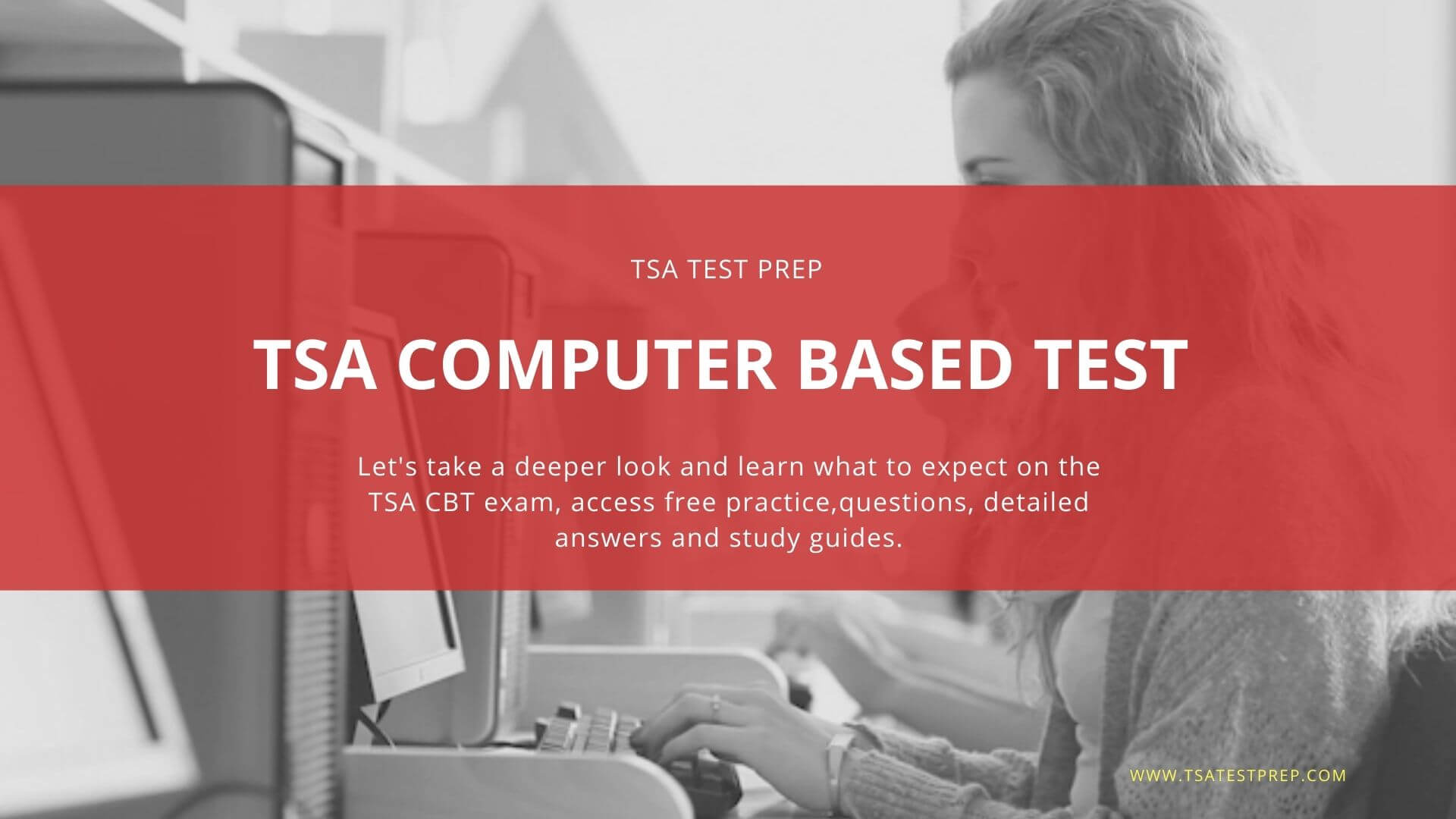
TSA CBT Practice Test & TSA Test Prep Free
The Transportation Security Authority Computer Based Test (TSA CBT Test), which can also be referred to as the Transportation Security Officer Test (TSO Test), is one of the early obstacles in the TSA hiring process. The TSA uses the results of the TSA testing to easily parse out quality candidates. A poor score on the TSA CBT will prevent you from moving on to the next stage in the application process. We are here to walk you through everything you need to know about the TSA Test including new changes to the exam. We have a newly updated TSA Study Guide and Practice Test for the new short form TSA Test and the more traditional longer TSA Assessment Test.
May 2023 Test Update: There is a new shorter version of the TSA CBT test being given to some candidates. The new short 25-45 minute version of the test will be given to only select candidates applying for positions at certain airports. We will walk you through everything you need to know about this new version. Let's learn more about the new Alternative Version of the TSA Test.
What Is the Transportation Security Administration (TSA) Exam?
The Transportation Security Administration Written Exam, often referred to as the TSA Exam, is the test applicants are required to take during their application process as TSA inspector, manager, or Transportation Security Officer. Currently there are two versions of the TSA test.
- The TSA CBT X-ray and English test which takes 2.5 hours, split over five sessions with designated breaks. It is made up of two main components: the X-ray Object Recognition Test (ORT), which includes 100 image-based questions, and the written section, comprising 50 to 60 questions. This is the more commonly given exam, and this test must be completed at an official TSA test site and can't be taken remotely.
- The Alternative Skills Test which is a shorter version lasting between 25-45 minutes. This alternative TSA test has three aptitude tests; connect the dots, image matching, and shape folding.
Let's take a deeper look at both versions of the exam.
Take a TSA CBT Practice Test.
What Topics Are on the TSA Computer-Based Test (CBT)?
There are two components of the TSA's CBT: Image Interpretation or the X-Ray Test, and the Written Skills Assessment.
What Is on the TSA X-Ray Test?
The X-Ray test, also known as the Object Recognition Test, is the more difficult of the two sections included in the TSA CBT test. We are here to answer for you some common FAQs. The more you know about the test going in the more confident you will feel on the test day. The most important thing is that you feel confident going into the test.
The X-Ray test, also known as the Object Recognition Test, is the more difficult of the two sections included in the TSA CBT test. This is because the content is unique to the position. On the image interpretation test, you will be shown images of baggage that have gone through the X-Ray machine. You will be given only 15 seconds to review the baggage and identify target objects. The target items will be forbidden items such as; weapons, bottles, shoes, drugs, or electronics. You will need to decide whether to pass, alarm, or hold a bag due to its content. If you pass the baggage, you decided the bag does not contain any harmful items. If you select alarm, you have indicated that the item has a prohibited item and you request police intervention. If you hold an item, you have identified a prohibited item which requires intervention by a TSO officer and further screening such as; physical search or use of Explosive Trace Technology (ETD).
What Is the Format of the X-Ray Test?
In the TSA X-Ray Test, you will be given X-Ray images of luggage filled with a variety of objects. Usually, you will be provided two practice sessions before you start the actual test. First, you will be required to memorize the shapes of three to six target items within a 30 second time frame. Then on the next screen you will be required to identify a target item, as per the instructions given, within a 15 second time period. This 15 second time limit can be challenging because some of the items are overlapping and at odd angles making them hard to identify.
What Type of Images Should You Expect to See?
In an X-Ray portion of the test, you will see a mix of dangerous and mundane objects embedded in X-Ray images. You will encounter threatening items like guns, knives, bombs, IEDs and so on. You will also encounter images with zero harmful items. It is your job to set an alarm if you find a contraband item in an X-Ray image.
How Complex Will the Images Be?
The X-Ray images you see will vary in complexity depending on how the target objects mix or overlap with other objects. There is no rhyme or reason to how complex an image might be. Some images will be more complicated than others. More complex images may require you to rotate items mentally in order to locate their outline or form, and may have the target item in an overlapping or weird angle. Some images may require you to locate various disassembled pieces of the contraband item.
What Are Some of the Items Which Are Banned?
The following is a comprehensive list of items that are banned in Carry-Ons and Checked Luggage.
How Do You Read an X-Ray?
There are both black and white and colored images. Interpreting an X-Ray can be quite challenging. Understanding the different color combinations and finding harmful items can be trickier than one would expect.
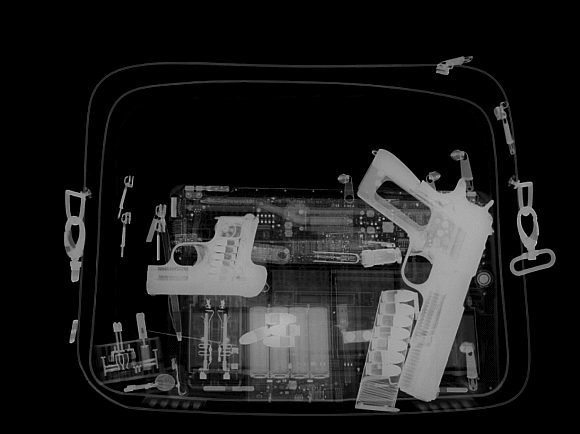
Black and white images are sharp. Depending what you are looking for the items can be easily visible. In these photos you can more easily parse out guns, bullets and computers.
How Do You Interpret X-Ray Colors?
If the image is not so straight forward you can use color detection. The basics to understanding color principles in X-Rays is knowing that the color highlights the difference in density of various materials. When an item is more dense it will be bluer. Conversely, less dense, lighter items will be on the red scale.
Blue/Black
The color blue usually denotes hard materials including; metal, hard plastics, alloys etc. Any wires, batteries, sunglasses, guns, etc. will show up on the blue/ black scale.
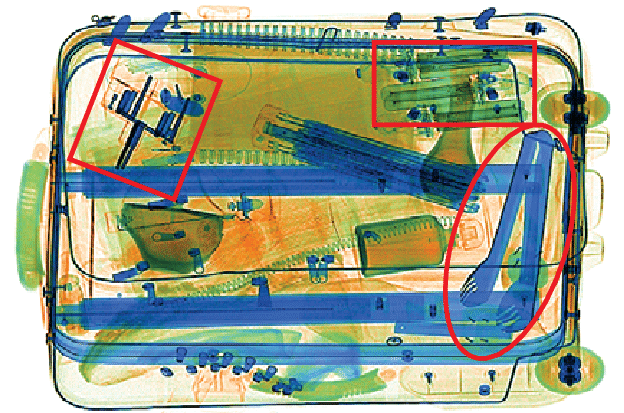
Green
Green represents less dense plastics and alloys. The combination of plastic and metal will most likely be some kind of electronic device.
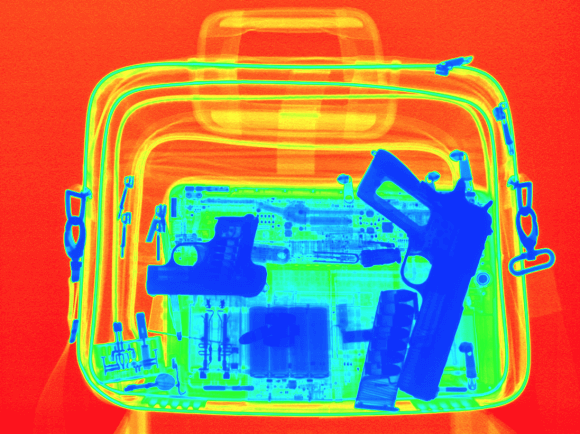
Orange
The orange represents any biological material. This covers natural items and some other materials including; rubber, food, leather, non-plastic explosives, liquids, gels and organic powders (like flour, baking soda, ect.). These colored items are often important to pay attention to because explosives are often partly composed of organic materials like glycerin, potassium nitrate, and TNT. Additionally, drugs such as heroin, cocaine, and cannabis are all classified as organic products. That's why identifying biological materials is extremely important.
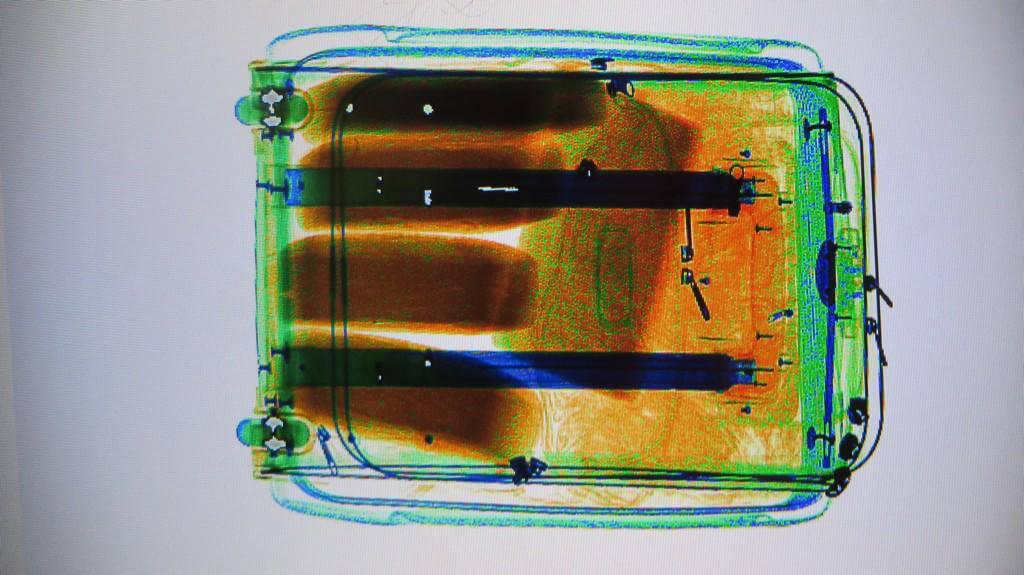
Red
Red zone indicates less dense items. This means the machine encountered little to no resistance when scanning the object. This object could be made out of light materials including; fabric, carton, or paper.
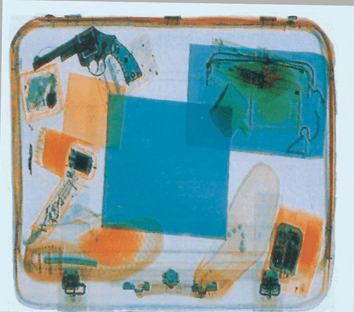
How Do You Read the Airport X-Ray Image?
Now that you have a basic understanding of the materials categorized by color, it is important to identify the outline of a target object. Often items might be placed on the conveyor belt at a random angle, or on top of another item, keep this in mind when detecting the object's outline.
Disclaimer:
There will be slight differences in color depending on the machine and manufacturer. Take a look at more TSA Assessment Test Questions and Explanations to understand the basic principles and nuances. Once you are hired as a TSO officer you will receive ample training on the subject.
How Many People Pass the TSA X-Ray Test?
The Object Recognition Test is by far the more challenging portion of the test. Only 30% of test-takers actually pass the test. In rare cases, those who pass the test may be asked to take it again just to make sure you actually passed due to your visual and cognitive skills, rather than sheer luck.
How Is the TSA CBT X-Ray Test Given?
The test is given at a specified testing center.There is no remote option. Make sure you arrive 30-45 minutes early to fill out any extra forms. The entire test takes a total of 2.5 hours and each section is given under time constraints. Each question in the Object Recognition Test is given with a 15 second time limit. The English portion of the test is all multiple choice questions. The test is very long which is why many find it difficult to stay focused.
What Is on the TSA Writing Skills Assessment?
The TSA Writing Skills Assessment test is a 50-60 question multiple choice test given with time constraints. This portion tests your understanding of basic principles of English grammar, word usage, syntax, sentence structure and paragraph organization. The test is broken down into three categories:
1. Reading Comprehension
The reading comprehension section measures your capacity for speed reading, your attentiveness to details, and your overall command of the language. You will be presented with a short passage followed by a set of multiple-choice questions. While the section is not complicated, it does demand the skill of rapid reading in order to correctly respond to each question within an allotted time of around 90 seconds.
2. Vocabulary
In this section, your vocabulary proficiency and spelling skills will be tested. You will be presented with a vocabulary word and tasked with identifying its synonym or antonym from a list of options.To do well in this section, it's essential to review vocabulary lists of common synonyms, antonyms, homophones, and frequently misspelled words.
3. Written Communication
In this portion, you will receive a sentence framework and be tasked with completing the blanks. The unique part is that you will be given a selection of word pairs. Some of these word pairs may be suitable for filling in the blanks but might include spelling mistakes, while others will not be appropriate at all.
Before taking the test make sure you are familiar with the following content areas:
- Sentence Construction
- Use of Phrases in Sentences
- Use of Clauses in Sentences
- Restrictive and Nonrestrictive Phrases and Clauses
- Verb
- Verb Voice
- Verb Tense
- Verb Mood
- Infinitive
- Gerund
- Participle
- Noun
- Pronoun
- Adjective and Adverb
- Article
- Preposition
- Conjunction
- Sentence Organization within Paragraphs
- Tense Shifts
- Punctuation
- Capitalization
It is IMPORTANT that you answer every question and note that there is an option D which states "no correction is needed" and this is a viable answer. For most applicants this information is rusty in their minds. They would most likely benefit from reviewing a TSA writing skills assessment practice test.
Check out this TSA Study Guide and Practice Test and preparation for the TSA Writing Skills Assessment portion of the test.
What Is the New TSA Alternative Skills Test?
The new short version of the TSA CBT test is specifically given to those applying to positions at a limited number of airports that are equipped with new advanced X-Ray machines. These machines enable the swift rotation of CT Scanner images of luggage in three dimensions (3D). As of May 2023, this NEW TSA exam is in use at approximately 5% of airports.The new short TSA CBT exam lasts between 20 to 45 minutes and is designed to test your spatial reasoning, attention, and processing speed. The short TSA CBT test DOES NOT contain any English or X-Ray interpretation questions. It is a completely different exam which consists of three test sections:
1. Connect the Dots
In this section, you'll be tasked with connecting dots labeled with numbers and letters and connecting them in their respective orders. First, you'll connect the dots in numerical order (1-2-3...), then you will need to connect the dots in alphabetical order (A-B-C...). Finally, you'll face a combination of both numbers and letters and you will need to connect the dots sequentially (1-A-2-B-3-C...). This section appears to be simple. But it requires some inside knowledge, success in this test is based on your ability to make these connections swiftly, while maintaining accuracy.
2. Image Matching
In this section you will be presented with a single image alongside five nearly identical images. Your task is to quickly and accurately identify the exact match. The faster you do this, the higher your score will be as you are given more points for each correct answer.
3. Shape Folding
This section is considered the most challenging part of the new TSA Test. You will be presented 2D shapes featuring numbered sides, and corresponding 3D shapes marked with letters. Your objective is to mentally fold the 2D sides to form the 3D shape, determining which number on the 2D side corresponds to which letter on the 3D shape. You will be given the following prompt "imagine folding the 2D image on the dotted line to make a 3D image, and tell us which number pairs with which letter?" It is IMPORTANT to understand that shapes are intricate and not basic cubes, which adds to the complexity of this section and makes it difficult for most individuals. Additionally, the 3D images are labeled with more letters than the 2D images are with numbers so they don't align exactly. For many candidates who did not expect to take this version of the test, they were overwhelmed and confused by this section.
The short TSA Exam is all about speed and accuracy. Prepare with this NEW Practice TSA Alternative Test.
FREE TSA Practice Test Questions, Answers, and Explanations
TSA CBT Test Sample Question Writing Skills Test
Writing Skills Test Instructions:
Choose the one answer that represents a correction that should be made to the sentence. If no correction is necessary, choose (D).
Once a request to bring firearms into a foreign country is approved, a Federal Air Marshal must send a notification to the Office of Foreign Operations to coordinate the request.
- change bring to brought
- change are to is
- change coordinate to coordination
- no correction is necessary
Answer + Explanation
The correct answer is B: change "are" to "is".
There must be subject/ verb agreement. The subject, "request," is singular and, therefore, the verb should be singular meaning "is" rather than "are".
Practice More TSA Writing Skills Test Questions.
TSA CBT Test Written Communication Sample Question
Supervisor Jones understands that it is essential for his TSA inspectors to understand each of the fundamental principals that apply to all procedures relating to canine training.
- Change "understands" to "understands those"
- Change "each" to "each and every one"
- Change "principals" to "principles"
- No correction is necessary
Answer + Explanation
The correct answer is C: change "principals" to "principles".
The meaning of the word "PRINCIPLES" is a rule or code of conduct. Whereas the word "PRINCIPAL" means someone with authority or first and foremost.
TSA CBT Test Vocabulary Sample Question
Writing Skills Test Instructions:
Choose the one answer that is the best revision to the underlined word(s) or phrase(s) in the sentence.
The TSO officer training program is long, grewling and fatieging.
- grueling/ fatieging
- grewling/ fatiguing
- grueling/ fatiguing
- grewling/ fateeging
- No correction is needed
Answer + Explanation
The correct answer is C: grueling/ fatiguing
This is a case of a spelling question. If you are not sure of the spelling on both words, focus on the word you do know. Don't spend too much time on this type of question. It is a good way for you to make up time for later more difficult questions.
TSA CBT X-Ray Test Sample Question
X-Ray Test Instructions:
Identify different types of guns found in X-Ray pictures of luggage. Each of the target items will be shown for 15 seconds. Then you will be presented with a set of questions. Determine if a gun appears in the questions that follow. If the item appears, press the number 1. If not, you should press the number 3.
Here are the items you will be given to study for 15 seconds:
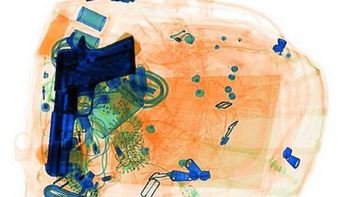
Answer + Explanation
Here we see the clear presence of a gun. We see the clear blue/black outline denoting the presence of metal. It is important to understand that the questions will get progressively harder.
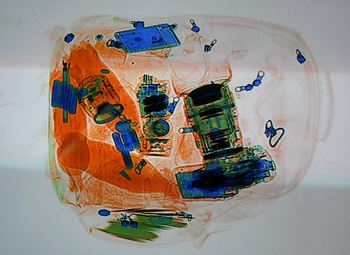
Answer + Explanation
We can see that there is no trace of a gun.
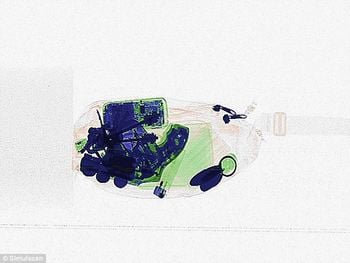
Answer + Explanation
Only the handle of the gun is visible in this picture. We can see the handle is presented in blue/black which represents metal, hard plastics, alloys etc. With an outer shell of green which can be the handles coating which is made of a plastic where the density isn't great enough to make it blue or black.
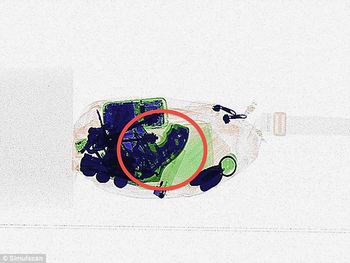
Full Disclosure
The X-Ray examples above represent the most basic format of the question. The actual test will present pictures with much more complexity. Images are presented from an easier, canonical viewpoint, and also from more difficult, rotated, or obstructed viewpoints. If you want more practice for your TSA CBT Test including sample X-Ray questions take a look at this TSA Exam practice test. What's great about this practice test is that it EXACTLY mimics the experience of the real exam. Giving you a taste of the types of questions and the time pressure.
New Short TSA CBT Alternative Test Sample Question: Shape Folding
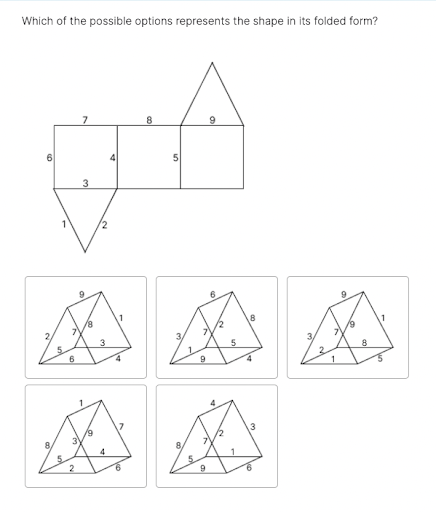
Answer + Explanation
The best way to answer these questions is to focus on the corners of the unfolded shape, specifically where three lines converge:
When examining the unfolded shape, it becomes apparent that 5, 8, and 9 will intersect at a corner when folded. Among the given choices, only the second choice follows this pattern. It's important to note that you could have selected any corner of the unfolded shape for analysis. In this explanation, we chose 5, 8, and 9 at random. If you chose a different corner and it didn't align with all the options, that's totally fine. Try folding the ones that match and consider trying a different corner also.
Prepare for the Short TSA CBT Test with this NEW Short TSA Aptitude Practice Test.
TSA Test Prep FREE TSA Practice Test
NEW! Ensure you are prepared on the test day by knowing what to expect on the TSA CBT Exam. Practice with more TSA Test prep free sample questions that include X-Ray pictures, Verbal Reasoning, Reading Comprehension, Vocabulary - Antonyms, Verbal - Sentence Completion exercises for FREE.
TSA Test FAQs
How Will You Know Which Version of TSA CBT Test You Are Taking?
The 2023 Short TSA CBT Test is currently being given exclusively for those applying for positions at certain airports that are receiving new X-Ray equipment. You will know which test you are taking based on the scheduling email you get from Pearson Vue. When you get the email from Pearson VUE to schedule your test if it contains the statement, "This assessment is not an English language proficiency assessment," this tells you that you will be taking the NEW SHORT TSA CBT test format. Another important indicator is if the email writes, "...expect to spend an average of 25-45 minutes in the test center." See the image below for an image on what the email should look like.
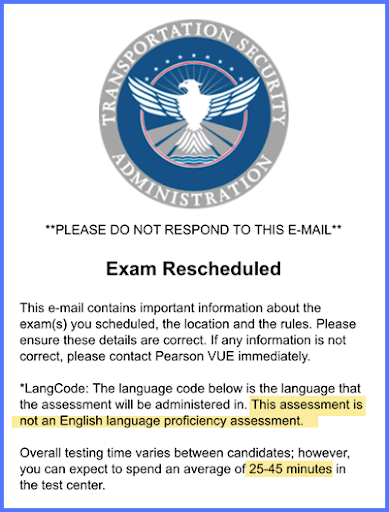
As more airports roll out with this new machine. The TSA Test will slowly over time start giving more candidates the new version of the test.
Is the TSA CBT Test Hard?
The test itself is not impossible. That being said, for most taking it the X-Ray section is a completely new playing field. It is extremely important to put in a little bit of effort to ensure that you pass the test. We partnered up with JobTestPrep to give you TSA Exam Prep with both practice for the long and short version of the test. No matter which version of the test you take both the X-Ray and the 3D shape folding section are something that require prior practice.
How Is the TSA Test Scored?
Applicants will not be penalized for wrong answers. Scoring is based on correct answers only. This means that it works in your advantage to take educated guesses. Your results on this exam will help place you into one of three categories:
- Best Qualified
- Highly Qualified
- Qualified
Scoring high is extremely important because those candidates placed in the best qualified category have the best chance of landing the job they want.
Don't be afraid to prepare in advance and use TSA computer based test practice materials to help gain a competitive edge.
What Happens If You Fail the TSA Assessment Test?
If you fail or do not attend your scheduled test time you will see an "X" on your application dashboard. This means you will be ineligible for any TSO openings for six months. Those who fail the CBT test or miss their scheduled time after two different CBT testing opportunities will no longer be eligible to take the TSA CBT test for the TSO position. It is important to try and pass the TSA CBT test on the first try. Even if you pass the test immediately the hiring process can be quite lengthy. There are many applicants in the pool, and you want to ensure if a job opens in your area that you are eligible.
What Happens if you Pass the TSA CBT Test?
Upon successfully passing the TSA CBT, you will be issued a Contingent Job Offer. Within a 14-day window, you will need to complete various forms, including the E86 National Security Questionnaire. Additionally, the TSA will do a credit check as part of the screening process. Successfully passing the TSO Test is a prerequisite to progressing to the subsequent stages of the hiring process. Learn more about each step of the TSA Hiring Process.
Who Can Take the TSA CBT Test?
The TSA CBT test is available only to U.S. citizens who are at least eighteen years of age and possess a valid high school diploma or its equivalent.
Why Does the TSA Use The TSA CBT Test?
The purpose of the exam is to identify candidates who can effectively safeguard travelers' safety nationwide. In addition to possessing proficient English skills, candidates must also show the ability to swiftly identify various items, which encompass potentially hazardous or prohibited items as well as commonplace objects like electronics, toys, or shoes. Similar assessments are used by security service companies such as GardaWorld and others in the industry. The new version of the test measures skills needed to use the new TSA X-ray machines.
How Can You Prepare for the TSA Test?
Take a TSA Computer Based Test practice screener in advance.
- Take a full-length practice test that mimics the actual test. It includes preparation for BOTH versions of the TSA exam.
- Know what to expect with the TSA Hiring Process.
- You can learn more about the test with these FREE TSA study guides.
- Talk to peers who took the test and see what experiences they had.
Start your journey to a rewarding career. Take a look at this TSA Exam Practice Test.
TSA CBT Test Tips
- Get a good night's sleep before the test and try to stay calm while taking it. You will get the best results if you avoid a test day panic.
- Carefully read the directions before every question. Do not assume you know what to do.
- Make sure you read the entire question and all the answer choices before choosing your response.
- Use process of elimination. The tests are multiple choice, therefore you can eliminate answers you are certain are incorrect.
- Your final test score is based on the amount of correct answers. There is no penalty for answering a question incorrectly. This mean, you should take educated guesses and leave no answer blank.
- All of the exams aside from the Federal Marshal Situational Judgement test allow you to go back and review your answers.
- Don't pay attention to answer patterns or number of As, Bs, Cs, Ds, or Es. The answer positions are completely randomized and there is no way to predict answers based on a pattern or sequence.
- Make sure to review a TSA CBT exam study guide before taking the exam. We like this one which includes practice for both versions of the test.
To learn more take a look at our TSA Test Prep YouTube Video.

Have a Question? Now You Can Ask TSA Test Prep!